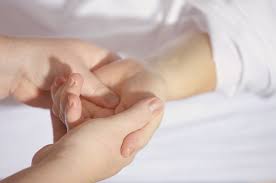
Tingling in hands, feet, arms and legs: causes and cures
Tingling can be associated with a wide variety of conditions, including prolonged pressure on a nerve, mineral deficiencies, multiple sclerosis (a disease that affects the nervous system causing weakness, difficulty with coordination and balance and other problems), and stroke, among many others
What is tingling in the hands?
Tingling in the hands, scientifically called paresthesia, is an abnormal sensation that affects the upper limbs, but can also commonly affect the feet, arms and legs.
This condition may be associated with altered sensitivity caused by disturbances of the nerve pathways, or with a kind of numbness. Tingling may be temporary or chronic.
Causes of temporary tingling
- Raynaud’s phenomenon; hyperventilation;
- compression of venous vessels with blood stasis.
Causes of persistent or chronic tingling:
- diabetes;
- sciatica;
- carpal tunnel;
- any condition capable of damaging the nervous system, such as a stroke, multiple sclerosis or, in extremely rare cases, a brain tumour:
- exposure to toxic substances, e.g. lead or radiation;
- certain medications;
- malnutrition;
- vitamin B12 deficiency;
- mineral deficiencies;
- nerve damage caused by infection, injury or overuse (e.g. in cases of professional use of pneumatic hammers or similar tools);
- alcohol abuse;
- cervical spondylosis;
- pressure on a nerve, e.g. in the case of a herniated disc;
- herpes zoster (in the case of post-herpetic neuralgia);
- damage to the microcirculation, e.g. caused by atherosclerosis, chilblains or inflammation;
- abnormal electrolyte levels (calcium, potassium, sodium) in the blood;
- insect bites and stings.
What leads to tingling in the hands?
The feeling of numbness in the hands, and in general tingling in the feet, head and legs or other parts of the body, is usually related to a number of conditions such as:
- vitamin or mineral deficiencies;
- nerve compressed for a long time;
- multiple sclerosis;
- stroke.
Other causes may include neck or head injuries, reduced blood flow to a specific area of the body.
Tingling in the hands can therefore lead to a variety of problems, some minor and some more serious.
It can also be the first symptom of very serious conditions, for which a doctor should be alerted.
What are the complications of tingling in the hands?
Tingling is a sign that one or more nerves are not functioning properly.
Complications related to tingling can vary depending on the underlying cause.
Since tingling can also be caused by serious pathologies, neglecting this symptom and not taking action can lead to serious complications and permanent damage.
Once the underlying cause has been identified, the treatments suggested by the doctor should be scrupulously followed in order to reduce the risk of complications, such as:
- coma or unconsciousness
- amputation of the limb;
- reduction or loss of vision;
- paralysis;
- loss of strength and weakness;
- extension of the tumour.
What are the causes of tingling?
Tingling can be caused by a wide variety of conditions such as a compression injury, including:
- fracture or dislocation causing compression of a nerve;
- herniated disc causing compression of a nerve;
- neck or back injury that compresses or injures the spinal cord or a nerve;
- carpal tunnel syndrome;
- head injury causing pressure or swelling;
- pressure on a nerve due to a growing mass or tumour;
- staying in the same position for too long, thus causing compression of a nerve.
Disease-related causes may be:
- diabetes;
- inactive or hypoactive thyroid (hypothyroidism);
- infections such as shingles;
- migraine;
- multiple sclerosis;
- Raynaud’s phenomenon;
- epileptic seizures or convulsions;
- stroke;
- transient ischaemic attack.
Other causes include:
- alcohol or tobacco abuse;
- deficiency or excess of various minerals such as calcium, sodium or potassium;
- heavy metal poisoning;
- side effects or interactions of certain drugs;
- exposure to radiation or radiotherapy;
- vitamin B12 deficiency.
What are the symptoms associated with tingling?
Tingling may accompany other symptoms typical of the underlying cause, including:
- bluish or cold skin in the same area or in the area surrounding the affected spot
- muscle weakness;
- numbness in the same area or in the area surrounding the affected spot;
- pain in the same area or in the area surrounding the affected spot;
- rash, especially on one side of the torso;
- epileptic seizures or convulsions;
- sudden changes in vision, loss of vision or eye pain.
What does tingling in the left arm entail?
Tingling in the left hand and tingling in the left arm must be carefully assessed, as they could be the first symptoms of a stroke.
In this sense, tingling in the right hand generally causes less concern.
This type of tingling is, however, quite common and it is good not to jump to hasty conclusions as it can also have less serious causes.
Most cases of tingling in the left hand and arm are due to overuse and fatigue of this part or even carpal tunnel syndrome.
Other causes of numbness in the left hand and arm include chest tightness syndrome and herniated cervical discs.
What does tingling in the head involve?
Head tingling can have a heterogeneous set of causes, which in turn require different types of interventions and remedies.
Tingling in the head most often can be generated by high stress, cervical conditions or anxiety.
Among the most common causes may also be a compressive injury, either in the back or neck, that damages the spinal cord.
More serious causes of persistent tingling in the head can include a tumour or a stroke.
What does tingling in the feet involve?
Paresthesia or tingling in the feet is generally a symptom that should not cause great concern.
It may in fact be due to a compression of nerves in the area, which in turn causes a reduction in blood flow.
In other cases, tingling in the feet may be related to more serious disorders. It may occur in patients with diabetes, or be a consequence of liver or kidney inflammation.
What does tingling in the legs involve?
Leg tingling is quite widespread and common and can be a symptom of various pathologies of different severity and extent.
The most harmless forms of tingling in the lower limbs generally tend to regress spontaneously and are often due to incorrect postures assumed for excessive periods of time.
A frequent condition of numbness and tingling in the legs, sometimes combined with a stinging sensation of discomfort or pain, may be an indication of various problems such as, for example
- herniated disc;
- cerebral stroke;
- neurological damage;
- nerve compression;
- restless legs syndrome;
- multiple sclerosis;
- sciatica;
- arterial embolism.
How is tingling diagnosed?
Tingling is diagnosed by a complete anamnesis (collection of the patient’s information and symptoms) and an objective examination (actual examination with collection of signs) by the doctor.
The diagnosis can make use of many other more or less invasive diagnostic tools, which vary depending on the disease that is supposed to cause the tingling, including: blood tests, X-rays, CT scans, MRI scans, ultrasound scans with colordoppler, biopsies.
What are the treatments?
The treatment of tingling depends on the upstream cause that led to it, which – as we have seen – can be extremely varied, ranging from diabetes to herniated discs: it is therefore not possible here to speak of a single therapy that is good for every situation.
The doctor will investigate the cause of the tingling and – once identified and if possible treated – it should diminish or disappear altogether.
What are the complications of tingling?
The presence of prolonged tingling may indicate that it is caused by even serious causes, so it is important to intervene early to avoid, in some fortunately rare cases
- amputation;
- coma or unconsciousness;
- loss of sight and blindness;
- paralysis;
- extension of cancer;
- loss of strength;
- death.
Read Also:
Emergency Live Even More…Live: Download The New Free App Of Your Newspaper For IOS And Android
Pain And Tingling In The Hands, Symptoms Of Which Disorders?
Healing Wounds And Perfusion Oximeter, New Skin-Like Sensor Can Map Blood-Oxygen Levels
Finger Twitching: Why It Happens And Remedies For Tenosynovitis
When A Finger Does Not Flex: Tenolysis Of The Extensor Tendons
Fibromyalgia: The Importance Of A Diagnosis
Electromyography (EMG), What It Assesses And When It Is Done
Carpal Tunnel Syndrome: Diagnosis And Treatment
Little Finger And Ring Finger Tingling: Symptoms Of Cubital Tunnel Syndrome




